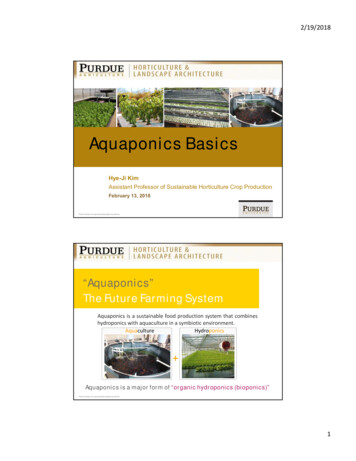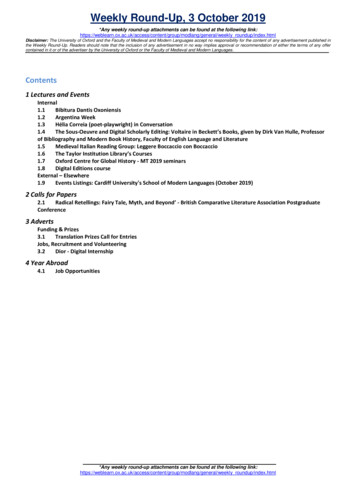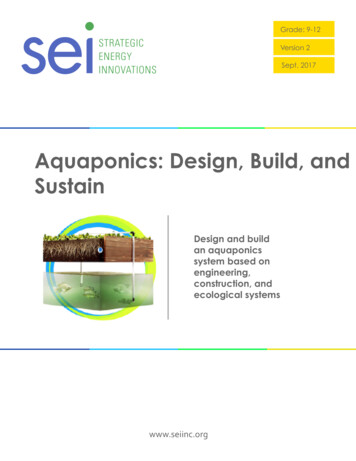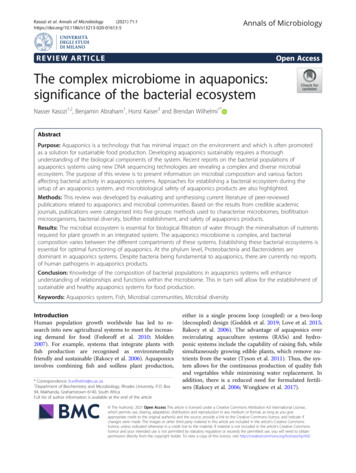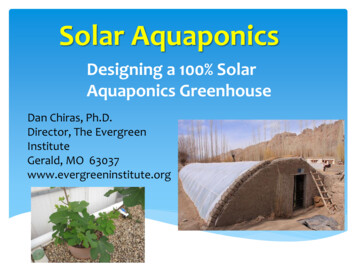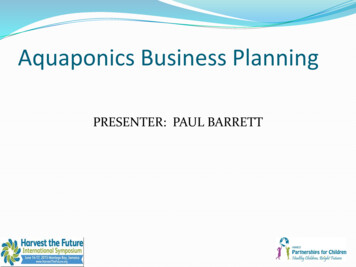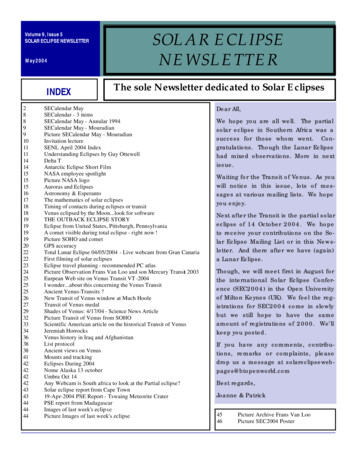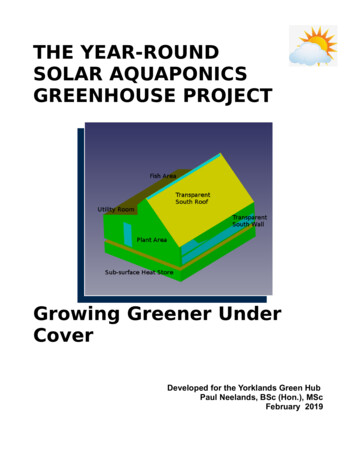
Transcription
THE YEAR-ROUNDSOLAR AQUAPONICSGREENHOUSE PROJECTGrowing Greener UnderCoverDeveloped for the Yorklands Green HubPaul Neelands, BSc (Hon.), MScFebruary 2019
TABLE OF CONTENTSPageINTRODUCTION11. Some Background Context: Ontario's Greenhouse Industry2PART I: THE YEAR-ROUND SOLAR GREENHOUSE FOR AQUAPONICSSustainable Low-impact Greenhouse Farming In Northern Climates,A Climate Change And Pollution Solution31.11.21.31.41.534566Aren't All Greenhouses Solar?New Greenhouse Goals for the Yorklands Green HubA Multidisicplinary Project within a ProjectMeeting Smart Cities "Circular Food Economy" StandardsMeeting U.N. Sustainable Development Goals (SDGs)PART II: THE GREENHOUSE BUILDINGSolar Greenhouse Structure and Layout72.1 The Structure2.2 Building Layout: The Interior Floor Plan78PART III: SOLAR AQUAPONICS GREENHOUSE HEATAND OPERATIONAL SYSTEMS103.13.23.33.4The Solar Heat Storage SystemsHumidity Control and Ventilation/Heat-Recovery SystemSystems Monitor and ControlBackup Systems3.4.1 Generator3.4.2 Pump Backups3.5 Utilities/Greenhouse Inputs10111111111111PART IV: FUEL USE AND GREENHOUSE EMISSIONS:SOLAR vs. CONVENTIONAL GREENHOUSES124.1 Heating Fuel Use and Greenhouse Gas Emissions Comparisons12PART V: THE FOOD-PRODUCING AQUAPONICS SYSTEMSolar Aquaponics Elements135.15.25.35.45.513141516History and EconomicsThe Closed-Loop Aquaponics SystemThe FishThe PlantsPest ManagementPART VI: GREENHOUSE ECONOMICS6.1 Projected Crop Yields1617PART VII: SIMULATING SOLAR GREENHOUSE THERMAL PERFORMANCE17i
7.1 Thermal Modeling Of Solar Greenhouse Heat Performance at3 Ontario Locations: Mount Forest, Windsor, And Thunder Bay177.2 Mount Forest187.2.1 Exterior/Interior Greenhouse Temperatures, Solar Only7.2.2 Exterior/Interior Greenhouse Temperatures, Solar plusSupplementary Gas Heating7.2.3 Fish Tank Temperatures7.2.4 Gas and Electricity Use for Heating Required for Mount Forest7.3 Windsor18191920207.3.1 Exterior/Interior Greenhouse Temperatures, Solar Only7.3.2 Exterior/Interior Greenhouse Temperatures, Solar plusSupplementary Gas Heating7.3.3 Fish Tank Temperatures7.3.4 Gas and Electricity Use for Heating Required for Windsor Compared toCommercial Non-Solar Greenhouses in Leamington7.4 Thunder Bay20212122227.4.1 Exterior/Interior Greenhouse Temperatures, Solar Only7.4.2 Exterior/Interior Greenhouse Temperatures, Solar plusSupplementary Gas Heating7.4.3 Fish Tank Temperatures7.4.4 Gas and Electricity Use for Heating Required for Thunder Bay22232324PART VIII: OPERATIONAL REQUIREMENTS FOR AQUAPONICS248.1 Daily, Weekly, Monthly, Systems Operations248.1.18.1.28.1.38.1.4Daily OperationsWeekly OperationsMonthly OperationsThree-Monthly Operations24252525PART IX: AQUAPONICS CALCULATIONS: SIZING THE SYSTEM25PART X: CONCLUSIONS AND OPPORTUNITIES FOR COLLABORATION26REFERENCESSUGGESTED READINGAPPENDICES272728Appendix 1: Fish and Plant Bed SizingAppendix 2: Greenhouse Building CostingAppendix 3: Aquaponics System CostingAppendix 4: Final TotalsABOUT THE DESIGNER - OPEN SOURCE DESIGNii2832363737
The Year-Round Solar Aquaponics Greenhouse ProjectGROWING GREENER UNDER COVERFig. 1 - The Invermere, B.C. Community greenhouseThe Invermere Community Greenhouse in B.C. is an example of a passive solar, season-extendinggreenhouse that functions for ten months of the year in Canada. It is modeled on the extensively-usedpassive solar greenhouses in China. Its low energy requirements and community partnershipprograms make it one excellent model which a full year-round solar greenhouse for Guelph mightfollow. /INTRODUCTIONAs the world confronts the challenge of climate change, practices in the global food supply arebeing called into review. This is notably true with respect to burning natural gas (a fossil fuel)for northern greenhouse crops, and the use and disposal of the hydroponic solution used togrow heavily-fertilized soil-less plants indoors for year-round human consumption. Natural gasis expensive and contributes to the climate change problem; nutrient solution disposalcontinuously pollutes waterways adjacent to greenhouse operations.Ontario's greenhouse operations are the most extensive in North America. Collectively theycomprise a 1.3 billion business that employs thousands of people and accounts for 70% ofCanada's vegetable crop area. At the scale of the agricultural industry, there is a clearopportunity for the development of less fuel-consumptive, less water-polluting methods offood production in greenhouses.1
This paper will explore the potential role of year-round, low-impact solar greenhouse farmingin northern climates as a solution to the energy consumption and nutrient disposal problemsof the greenhouse industry. On a more local level, and in relation to the vision of theYorklands Green Hub, it will outline ways in which solar greenhouse farming can offer a newapproach to community participation in food production, research in this new area, andsustainable food systems education.The concept of growing-season-extendingsolar passive greenhouses which uselittle or no artificial heating has beenextensively developed in China over thepast four decades to grow fresh greensfor northern cities, and the capital Beijingin particular. Over this time, repeatediterations of greenhouse design haveFig. 2 - Early brick walled,progressed from thick adobe-brickstraw-covered ChineseFig. 3 - Modern pre-fabstructures (Fig. 2) to pre-fab insulatedpassive solar greenhouse.version of a passive solarsouth-facing green-houses (Fig. 3) thatChinese greenhouse.create growing environments which have now been successfullytested and introduced in northern locations in several other countries.1. Some Background Context: Ontario's Greenhouse IndustryThe greenhouse business in Ontario is the largest inNorth America with 1,443.8 hectares of greenhousesunder cover, primarily in the Leamington – Kingsvillearea. Commercial greenhouse operators calculateheating requirements and associated natural gasconsumption in terms of heating cost per hectare.The fuel cost of heating these facilities amounts to 137.25 million dollars per year in natural gas 1. Thisamounts to a fuel cost of 95,063 per hectare, whichhas a significant impact on operating margins.Carbon dioxide emissions from thesegreenhouse operations are alsosignificant, at 1,231,065 kg2 of CO2 perhectare for a total of 1,777,411,647 kg ofCO2 per 0.3 mg/L3.0 mg/LPhosphorus33.6 mg/L0.03 mg/LPotassium180 mg/Lmg/LCopper300 μg/Lg/L5.0 μg/Lg/LFig. 4 - Waste Nutrient Loadings to Surface WatersThe second serious drawback ofOntario's current greenhouse foodproduction is water pollution. Most of thefood producing greenhouses arehydroponic - they grow plants in a heavily fertilized soil-less water environment. In thehydroponic solution a buildup of sulfates, chlorides, and bicarbonates occurs, and adian-steel-industry/51932
quantities of spent nutrient solution must be disposed of regularly. Much is released into –and pollutes - local waterways. In the Leamington area, some streams are polluted far aboveregulatory levels3. Pollutant concentrations vs. provincial standards are shown in Fig. 4.The Ontario Ministry of the Environment has stated:“The MOE cannot support further greenhouse development within either watercourse(Sturgeon Creek and Lebo Drain) without appropriate treatment technology in place.” 4PART I: THE YEAR-ROUND SOLAR GREENHOUSE FORAQUAPONICSSustainable Low-Impact Greenhouse Farming In NorthernClimates, A Climate Change And Pollution Solution1.1 Aren't All Greenhouses Solar?All greenhouses use sunshine to grow plants. But a"solar greenhouse" is a greenhouse with passive andactive heat storage systems, improved insulation, andinsulating glazing that allows for extended or all-seasongrowth of fruits and vegetables under cover. It uses solarenergy to produce all or most of its required heat - dayand night, year round. This is a tested technology. Overthe past four decades, China has built in excess of1,250,000 hectares of solar greenhouses (Fig. 5) 56.Fig. 5 - Hectares of solar passiveThe present proposal for a solar-heated recirculatinggreenhouses in northern China.aquaponics greenhouse is designed to address heatingcosts, greenhouse gas emissions, environmental pollution problems - and extend the indoorgrowing season - in an Ontario context.Conventional Canadian greenhouses are most often one of two types: flexible polyethylenehoophouses on steel frames, or rectangular, double-layered rigid polycarbonate structures.Both types use expensive natural gas to maintain year-round growing temperatures.A solar greenhouses, by comparison, is designed to maximize the absorption and storage ofavailable solar heat, and lessen or eliminate the need for artificial heating. This type ofgreenhouse is glazed only on the south-facing front and roof, while the back and side wallsare thick and well-insulated to prevent absorbed heat from dissipating. The building employstwo methods of heat storage:a) a heat store of stacked interior water barrels (see Fig. 10) which provide thermalmass to absorb solar heat, project-2010-and-2011https://mte-d.com/ /12/reinventing-the-greenhouse.html3
b) a sub-floor rock heat store (see Fig. 11) within an insulated concrete foundation,which retains the solar heat from daytime sunshine.Solar heat stored in the water and the rocks is released and re-circulated at night to maintaina suitable temperature range for plant growth.The first of these systems, a wall of stacked water barrels, is a passive solar system: thewater absorbs and stores solar heat during the day and simply re-radiates it back into theindoor space at night. The second system, the sub-floor rock store is an active solar system:it uses an electric fan to blow daytime-heated air from the roof peak down into theunderground rock store; at night the fan reverses, blowing stored heat back up into thegreenhouse growing space. Insulation plays a key role in creating a building envelope whichretains the heat acquired during the hours of daily insolation (sunshine) for indoor recirculationat night.The Year-Round Solar Aquaponics Greenhouse Project incorporates this combined passiveactive solar heat-store approach with an aquaponics food-growing system. Aquaponicsintegrates the hydroponic (water-only) cultivation of food plants with the raising of fish whichsupply the nutrients for the plants. This combination offers potential benefits for yearround indoor farming systems which are low on energy consumption and low on waterconsumption (the water is continuously re-circulated). It also eliminates the need forregular, polluting disposal of waste nutrient solutions, as the fish supply the nutrientsfor the plants. Organic certification for aquaponics systems is currently underdiscussion and will not be covered here.71.2 New Greenhouse Goals For The Yorklands Green HubThis Year-Round Solar Greenhouse Projectfor the Yorklands Green Hub proposesbuilding a 26 x 30 foot aquaponics greenhouse largely heated by natural solar heat.With this type of greenhouse, solar heatingcan address the heating cost problem forundercover winter food production, andlargely eliminate carbon dioxide emissions.Aquaponics – the integrated recirculatingcultivation of fish in tanks and plants in deepwater culture – can address the external waterpollution problem and greatly reduce thevolume of water use.The proposal details which follow describe thecontext for the timeliness of this type ofproject, details of the greenhouse structureand heat-retaining systems, and anexplanation of aquaponics as an efficient and7Fig. 6 - An example of a small aquaponic systemgrowing fish (tilapia) and greens (lettuce and bokchoy) at the Mississauga Food Bank.Bagent, Will. Something Fishy About Aquaponics? Organic Council, Sept. 19, ent/4
sustainable local food-growing system. The descriptions are followed by day-by-day modelingof the projected solar heating performance for this type of project at three different Ontariolocations: Mount Forest, Thunder Bay and Windsor.The goals of this proposal are three-fold:1) to build and conduct performance testing on a suggested model of a demonstration,commercially viable low-energy solar greenhouse suitable for growing crops yearround, with results of thermal performance monitoring to be used for possible revisionsand future iterations;2) to describe and build the basic components and operation of an aquaponics system forgrowing interdependent greens and fish year-round in Ontario, Canada, at theYorklands Green Hub site in Guelph, with results of biological systems monitoring to beused for possible revisions and future iterations;3) to find and engage an architect or civil engineer (possibly working with architecturalstudents) to produce finalized plans and specs and obtain approvals for construction ofthis greenhouse.The inspiration for this project was the 1970s PEI Ark (Fig.7), a model self-sufficient bioshelter that included anaquaponics system in a greenhouse (seehttps://peiark.com/introduction/).Fig. 7 - West view, the PEI Ark.1.3 A Multidisciplinary Project within a ProjectIn essence, this proposal offers two separate projects, one within the other. The first focus isto model, build and test a sun-heated greenhouse capable of allowing year-round indoorcultivation in Ontario. The second is to outline, for further detailed design development, thecomponents of an aquaponics (fish and greens-growing) system which would work inside thegreenhouse. These two elements of the project, the building and the food-growing system,are described separately in Part II and Part III below. It is envisioned that this project is likelyto require at least two or more independent teams of participants: the builders/energymonitors and the food producers/aquaponics monitors.In terms of community participation and input into a solar greenhouse project in Guelph, therange of scholarship and expertise which could be brought to bear on this new kind of foodgrowing facility is very broad. Consultation and input from fields as broad as architecture,engineering, solar design, construction, agriculture, aquaculture, integrated pestmanagement, community collaboration, sustainability fundraising, and community food-relatedpartnerships would all be relevant.This project could benefit from the input and involvement of students and interestedprofessionals in a variety of disciplines, to elaborate further on details specific to their areas ofstudy.5
1.4 Meeting Smart Cities “CircularFood Economy” StandardsBuilding a solar greenhouse in Guelph wouldsupport the local food movement bydemonstrating a new way to provide fresh food,incur little food transportation time and cost, andreduce spoilage. It would model energyconservation and aquaponics, invite innovativepartnerships between food production and use,and explore the future business viability of buildingminimal gas heat winter greenhouses.This innovative agricultural closed-loop, waterefficient, non-polluting cultivation infrastructure fitswith YGH's participation in the Town of Guelph'sbid for funding under the Smart Cities Challenge:it is an ideal example of design for a “circular foodeconomy.”8 The program's Smart Cities Bookletstates: “The Circular Food Economy Lab willfoster partnerships and collaborations to re-inventlocal food systems and solve local food problems that are globally relevant.” 9The solar aquaponics greenhouse fulfills this criterion, which makes it an ideal YGHcontribution to the city's collaborative project. The Smart Cities Challenge further states, “We’llshrink our environmental footprint by reducing waste. We’ll create new revenue streams andnew jobs by extracting value from the by-products we currently throw away. 10“ In a solargreenhouse, heat, water and fish waste are all recycled, with nutrients from the fish beingmonetized through conversion to plant fertilizer.1.5 Meeting U.N. Sustainable Development Goals (SDGs)On January 1, 2016, the United Nations' 17 Sustainable Development Goals (SDGs) of the2030 Agenda for Sustainable Development came into force. These goals, designed to beappropriate for universal application, aim to mobilize efforts to eliminate poverty, fightinequality and address climate change.8 https://guelph.ca/wp-content/uploads/SmartCities Booklet.pdf9 ibid10 ibid6
This solar greenhouse project contributes to several United Nations Sustainable DevelopmentGoals (SDGs) as a community build, management, research and training facility whichaddresses food, energy, water and climate issues: Goal 2: End hunger, achieve food security and improved nutrition and promotesustainable agriculture.Goal 7: Affordable and clean energy. Ensure access to affordable, reliable, sustainableand modern energy for all.Goal 8: Promote inclusive and sustainable economic growth, employment and decentwork for all.Goal 9: Build resilient infrastructure, promote sustainable industrialization and fosterinnovation.Goal 13: Climate action: take urgent action to combat climate change and its impacts.PART II: THE GREENHOUSE BUILDINGSolar Greenhouse Structure and Layout2.1 The StructureThe proposed demonstration solar greenhouse measures 7.9 by 9.14 metres (26 x 30 ft.).The walls and back roof are built of wood, framed with steel-sheeting exteriors and interiors.All walls have an 8” layer of foam insulation inside them, which provides an insulation value ofR 44 (US) or RSI 7.74 (CDN).In order for the insulation to work effectively, the building must have a tight and effectivevapour barrier inside the inner wall surface. The outside of the insulation has a layer of Typaras a moisture-permeable wind barrier. Heavy insulation prevents the greenhouse fromdropping to freezing temperatures, allows the growing season to be extended to about tenmonths of the year using only solar energy and twelve months of the year with minimal gasheat. This reduces gas-heating to a fraction (11%) of what is required in conventionalgreenhouses.The south-facing sloped roof and vertical front wall are steel-framed, with a triple layer oftransparent polycarbonate glazing. Tripling the layers of roof and front glazing helps retainheat with an R factor of R 2.5.Fig. 8 below shows the main architectural features of the solar greenhouse.7
Fig. 8 - Solar Aquaponics Greenhouse Features2.2 Building Layout: The Interior Floor PlanThe proposed floor plan of the solar greenhouse is comprised of three main areas:a) a front 4.26m x 9.13m (14 x 30') plant cultivation area beneath the transparent glazing,divided into three sections: 4 deep-water-culture floating raft plant beds for greens such as lettuce, spinach orbok choi, which take 5 to 6 weeks to mature 2 nutrient film-techqnique (NFT) areas for fruiting plants such as tomatoes,cucumbers or peppers, beans, which take 12 weeks weeks to mature walkways for maintenance and harvesting8
b) a 3.65m x 6.1m (12 x 20') rear fish-raising and filtration equipment area which includes two fish tanks to accommodate 263 tilapia (fish), a sedimentation tank, a biologicalfilter,and a sump. Additionally, this room includes a sink for cleaning the fish-raisingareac) A 3.05m x 3.65m (10 x 12') rear utility room equipped for cleaning, processing andrefrigerating vegetables and fish for sale, and a sprouting nursery for new plants.The latter two spaces are located behind, and shaded by, a central dividing wall lined on thefront side by the stacked water barrels. An illustration of this proposed arrangement is shownbelow in Figure 9.Fig. 9 - Interior Solar Aquaponics Greenhouse LayoutLeft: Utility Room/plantnurseryRight. Fish tanks andwater filtration systemThermal storage waterbarrelsGrowing area: 4 floating raftplant beds 2 NFT (nutrientfilm technique)bedsNote: a recirculating watersystem connects the fishtanks to the plant beds toprovide nutrients and filterthe water.Appendix 2 below provides a detailed breakdown of estimated of costs for the construction ofthe solar greenhouse building9
PART III: SOLAR AQUAPONICS GREENHOUSE HEAT ANDOPERATIONAL SYSTEMS3.1 The Solar Heat Storage SystemsThe greenhouse's passive (water barrels) and active (rock store) solar heat storage systemsprovide the majority of the year-round warmth required for plant growth.a) The passive heat storage unit consists of thirty-three208-litre (45-gallon) red or blue coloured water barrelsstacked in front of the 4”-thick insulated white (reflective)central dividing wall of the greenhouse (see Fig. 10 ).Fig. 10 - Stacked water barrels (redor blue is preferable) serve as a heatstore, warmed by the sun by day,releasing heat by night.The sun-warmed thermal mass of the water in thesebarrels will alone keep the greenhouse from freezingshould the power fail.b) The active heat storage systemconsists of a one metre thick bed of riprap rock below the entire greenhousefloor, inside the insulated concretefoundation. An example is shown in thefacing image, (Fig. 11). A single 50-wattfan circulates sun-warmed air ductedfrom the peak of the greenhouse downinto the porous rock bed to heat it.When the greenhouse interior coolsdown at night, the fan reverses andblows warmed air in the rock bed backup into the greenhouse space. Insummer, if the greenhouse temperature Fig. 11 - An example of a sub-floor rock store in agreenhouse, with a fan.rises above 25 C, motorized,thermostatically-controlled vents at thetop and bottom open to prevent overheating. In the winter, to ensure that the interiorgreenhouse temperature does not drop below 16 C, a through-wall natural gas heater isincluded as a backup system for the coldest days and nights, and for extended periods ofcloudy weather.The walls and back ceiling enclosing these systems are well-insulated with foam insulation,and reinforced with a tight and effective vapour barrier.10
3.2 Humidity Control and Ventilation/Heat-Recovery SystemTo prevent excess humidity from accumulating inside the greenhouse, this demonstrationmodel includes an air to air counterflow heat exchanger. Acounterflow heat exchanger works by recovering the heat fromwarm exhaust air and transferring it to the cooler fresh air inletstream. This simple but effective heat-transfer technologyprovides a continuous air exchange between the inside of thegreenhouse and the outside, while, importantly, conservingthe hard-won interior solar heat during the air exchange. Theventilator is driven by two fans, and sized to provide onecomplete air exchange every 8 minutes, which gives anexchange flow of 0.4 cubic metres of air per second. ConstantFig. 12 - Outflowing warm airventilation removes humid air from the greenhouse whileheats incoming cool fresh air inkeeping the carbon dioxide level up by supplying fresha counterflow heat exchanger.outdoor air and minimizing heat loss.3.3 Systems Monitor and ControlAn off-the-shelf system monitor continuously monitors and controls air temperature and watertemperature for fish and plants, and dissolved oxygen and pH of the fish water. It alsomonitors and controls water levels throughout the system, and can start backup equipment ifneeded. It is programmed to notify an operator in case of a fault condition.3.4 Backup SystemsGuelph is susceptible to occasional power outages. And fish have a low tolerance of abruptchanges in their environment. To protect both plants and fish in case of any system problemsthat might affect consistent heating, aeration or system circulation, backup electrical andpumping equipment are recommended.3.4.1 GeneratorSince fish cannot survive more than 5 minutes if deprived of oxygen, a backup autostart natural gas generator is needed to ensure the air-pump and recirculating pumpare working at all times in case of power interruptions.3.4.2 Pump BackupsA redundant water pump and air pump are provided to automatically take over shouldthe primary pumps fail.Should a backup system engage, the systems monitor will notify a trained operator,who will take appropriate followup action.11
3.5 Utilities/Greenhouse InputsThe greenhouse is designed to be fully connected to public utilities – electricity, water andgas. It requires electricity for lighting, running the active solar and ventilation fans,refrigeration, heating water for the kitchen/food processing station, fish area sink, andpumping for the fish tank aeration and whole-system water circulation. It requires water forthe fish and aquaculture systems, and for cleaning and processing. Natural gas is needed forsupplementary heating on cold winter days and nights.Renewable energy (solar and/or wind) as a power source could be considered as part offuture planning of YGH's integrated demonstration projects.Natural gas is needed for supplementary interior heating for the coldest days of winter. Wateris required for the aquaponics system, for cleaning and processing fish, and maintaining theoverall facility. (This plan does not include washrooms.). Natural gas: It is estimated that supplementary winter heating for the greenhousewould require 230.5 cubic metres of natural gas, costing 46.10 for a year.Electricity: for lights, fans and pumps would require 423.23 kilowatt hours of electricitycosting 65.59 for a total of 111.69.Water: to replace water lost to evapo-transpiration, and for washing, cleaning and foodpreparation.Appendix 3 below provides a breakdown of the estimated costs to build the aquaponicssystem described.PART IV: FUEL USE AND GREENHOUSE EMISSIONS: SOLAR vs.CONVENTIONAL GREENHOUSES4.1 Heating Fuel Use and Greenhouse Gas EmissionsComparisonsA conventional greenhouse of equivalent size to our demonstration model (72.2 m 2.) wouldhave a fuel cost of 686.41 per year. For commercial scale solar greenhouses this would givea fuel cost of 13,802 per hectare, or 11% of the cost of a conventional greenhouse which hasa fuel cost of 95,063 per hectare. The greeenhouse would produce 450 kg. Of CO 2 per year;a convential greenhouse of this size would produce 6,692 kg. Of CO 2.Carbon dioxide emissions from greenhouse operations for this proposed model solargreenhouse would be 69,011 kg11 of CO2 per hectare, compared to 1,231,065 kg12 of CO2 perhectare for a conventional greenhouse.11 y/519312 y/519312
PART V: THE FOOD-PRODUCING AQUAPONICS SYSTEMSolar Aquaponics ElementsThe food-producing part of the project outlined here describes in broad strokes the basicrequirements to set up a fish and vegetable-producing aquaponic system inside the solargreenhouse. At the date of writing, aquaponics appears to be a new introduction to Guelph.This presents an opportunity for research and practical experimentation in developing andfine-tuning this type of integrated food system. The main, integrated, parts of the system arefish tanks, plant beds and a bacterial filter, with a nutrient-circulating water system thatconnects them. The physical setup and the types of fish and plants to be grown will beoutlined in this section. For a more complete introduction to this water-efficient, non-pollutingmethod of aquaculture, see The Aquaponic Farmer: A Complete Guide to Building andOperating a Commercial Aquaponic System, by Adiran Southern and Whelm King (2017) inthe References section below.135.1 History5.1.1 AquacultureC. F. Hickling citing S. Y. Lin a noted Chinese aquaculturist puts the start of Chinese freshwater aquaculture during the period 2000 – 1000 BC using the silver carp. In 473 BC Fan Laipublished his book “The Classic of Fish Culture14”for the common carp. During the period 618to 906 A.D fish culture expanded to include the silver carp, the big-head carp, the grass carpand the mud carp. During the period 1644 to 1911 AD, fish culture expanded to India, FrenchIndochina, Europe, and North America wherea book was published “A Manual of FishCulture” in 1897. Many attempts were startedin Africa involving the species tilapia, commoncarp and catfish. Today the decline in wild fishstocks has increased the demand for farmedfish. Rainbow trout are the most common withabout 48 million pounds raised annually 15 inthe US. Aquaculture, or the culturing of fish ina controlled environment, now accounts for 50percent of the fish consumed globally16. Themost common farmed fish now are carp,salmon, tilapia, and catfish17. Good animalwelfare involves Five Freedoms from theFarm Animal Welfare Council of GreatBritain18:1. Freedom from hunger & thirstFig. 13 - The aquaponics cycle converts fish wastes to2. Freedom from discomfort131415161718food for plants, and provides oxygen from the plants forthe t-fish-farmed.htmlBased on data sourced from the FishStat databaseArchived November 7, 2012, at the Wayback nimal-welfare-committee-fawc13
3. Freedom from pain, disease, or injury4. Freedom to express normal behaviour5. Freedom from fear and distressA aquaculture system provides these needs by:1. Feeding on a regular schedule.2. Controlling the temperature to that required by the fish species without suddentemperature changes.3. Controlling the fish density.4. Adeq
The Year-Round Solar Aquaponics Greenhouse Project incorporates this combined passive-active solar heat-store approach with an aquaponics food-growing system. Aquaponics integrates the hydroponic (water-only) cultivation of food plants with the r
